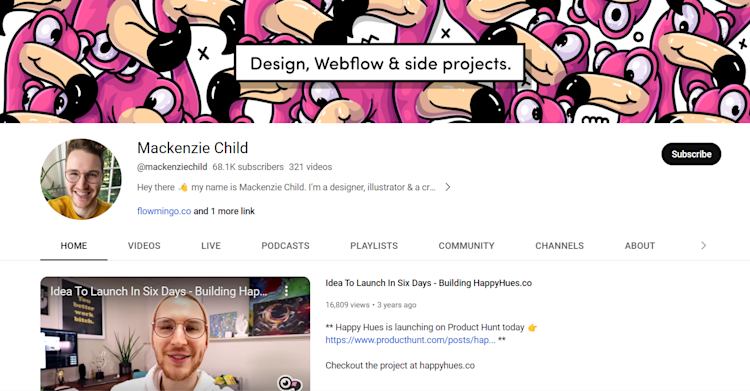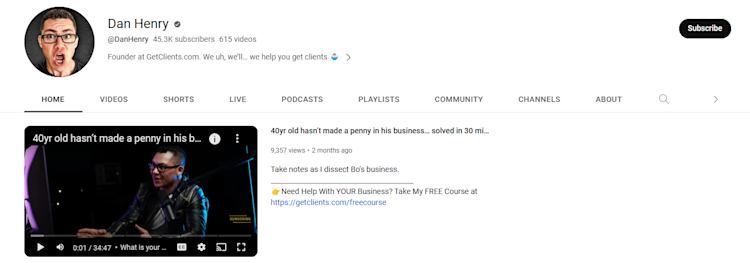Check you out -- you’ve got a growing YouTube viewership.
And now, you’re brainstorming ways to monetize your channel.
Contrary to what the mainstream may tell you, there are ways to monetize your videos without relying on fancy brand deals or needing a gargantuan following.
Enter . . . your online course.
That’s right, you can sell your online course to your YouTube audience, and on your YouTube channel.
Today, we bring you five straightforward steps for selling online courses to your YouTube audience using your channel.
Let’s get straight to it.
5 simple ways to sell online courses on your YouTube channel
#1. Vet your online course idea among your YouTube audience
This first step is more of a pre-step, but a vital one nonetheless.
It’s important to first make sure you have a winning idea that resonates with your YouTube audience before creating your online course.
Your audience is the most reliable source for telling you what they want and need. The last thing you want to do is guess what your audience needs, and then find yourself selling an info product they didn’t want in the first place.
That’ll only bring you crickets -- not sales.
Conducting customer research puts you ahead of the game. Sadly, less than 40% of marketers use consumer research to drive their decisions.
To do your research, start by combing through high-level video analytics. Check out the most popular videos to find out which topics your audience is most interested in.
But as you brainstorm your course ideas, don’t stop at examining just your video topics.
It’s also wise to comb through the comments to dig a little deeper into your audience’s biggest problems. Reply to relevant comments and ask your audience directly what they want to learn more about or what they need the most help with.
Then, take it up a notch and ask your YouTube audience what they want to learn more about at the end of your videos.
Creator and founder of 5Four Digital (among other successful business ventures), John D. Saunders, goes as far as asking his audience to review his course curriculum as he’s creating it, like in this tweet thread.
He not only asks his audience what to include in his course lessons, but he also asks for pre-sales, which guarantees sales on launch day.
The way John involves his audience in the course creation process is so on-point for delivering exactly what his audience wants that it brought in $10,000 in course sales on launch day.
Pretty impressive, right?
The point is:
Thoroughly investigate what your audience’s biggest needs are to make sure your course is something they’d buy into. And do the research before creating your online course.
From there, it’s about positioning yourself as the expert on your YouTube channel, which brings us to our next topic.
#2. Optimize your channel to reflect your expertise
Once you’ve got a winning course idea underway, it’s time to optimize your YouTube channel. Everyone that visits your page should clearly understand what you do and what specific problem you help solve.
Update your channel everywhere to reflect your area of expertise, starting with your channel art.
For a great example, look to successful entrepreneur Ryan from Signature Edits, who includes the tagline, “making photography simple,” in his channel art.
Or talented creator Mackenzie Child who features “Design, Webflow & side projects” on his YouTube channel art.

This way, your area of expertise is crystal clear to your audience.
Another place to update your channel to reflect your expertise is in your “About” page.
Update your About tab so people who click on the tab can explicitly understand who you are and what you help people solve.
Tim Ferriss does a great job of this on his channel, and he’s someone who’s known for not one but several achievements.
Even though Tim’s wheelhouse extends beyond any one skillset, his About description still explains his versatile talent by listing some of his well-known achievements, like being one of Fast Company’s “Most Innovative Business People” and Forbes’ “Names You Need to Know”.
To write effective descriptions and copy on your About tab, keep the length in mind.
These days, less than 300 words are all you need to successfully voice your point.
And as far as complexity in your copywriting goes, simplicity wins. A middle school reading level or below will score you more readers. After that, it becomes difficult to read your copy.
In fact, a Boomerang study found the messages written at a third-grade reading level received 36% more responses, so simple is the name of the game here.
All in all:
Update your channel art and About page to highlight your expertise. This helps communicate to your YouTube viewers how you can help them.
And while you’re updating your YouTube channel, follow our next tip.
#3. Include links to your lead magnet everywhere possible
This step is crucial for moving your audience from free YouTube viewer to paying student online -- update your YouTube channel to include links to a helpful lead magnet.
While it may be tempting to include links that go straight to your online course sales page, it’s a much easier ask to start with the small stuff and offer a lead magnet first.
Even though your end goal is to sell your online course, it’s wise to make your immediate goal to collect your audience’s email addresses from your YouTube channel.
Why? When you capture your viewers’ email addresses, you can stay connected to them and nurture them toward your online course.
Email, after all, is still king. So much so that it brings in a whopping $42 ROI for every dollar spent on email marketing.
Plus, a major 81% of small and mid-sized businesses rely on email as their main source for acquiring new customers.
So, include a link to your lead magnet wherever possible -- like your description, end screen, annotations, and cards -- on your YouTube channel and in your published videos.
Check out how rockstar entrepreneur, Amy Porterfield, includes a link to her Work From Home PDF guide on her channel’s main header links . . .
As well as in her description below her published video . . .
Basically, once you have a lead magnet and updated links on your channel pointing to the opt-in page, you can collect your audience’s email addresses. From there, it's about nurturing your relationship in their inboxes and warming them up to purchase your online course.
Our fourth step is also another way to direct people to opt-in for your lead magnet.
#4. Create a trailer video that points viewers to your lead magnet
Your fourth step is to create a video that leads people to your opt-in page and post it as your channel’s trailer.
While it may seem more promotional than your channel’s other video content, consider it a worthwhile video marketing tactic.
After all, 91% of marketers are happy with the ROI they get from videos on social media, and YouTube certainly counts as one of those channels.
What’s more, an astounding 92% of marketers say video is an integral part of their marketing strategy, which is up from 78% just five years prior.
All these video marketing stats to say, it’s smart to work a bit of marketing into your video content, namely your channel trailer, which takes up prominent real estate on your channel’s home page.
To steer people to your lead magnet in your channel trailer, you can focus the main points in your video content on your lead magnet, just like successful entrepreneur and course creator, Dan Henry does, where he guides people to opt in for his online course.

Or you can simply include it as an aside in your channel's main header, just like successful entrepreneur and author Ramit Sethi does.

Either way, the main takeaway is to leverage your channel trailer and include a call-to-action (CTA) in your video footage and description that points people to your lead magnet opt-in page.
This way, all your bases are covered for capturing as many of your audience’s email addresses as you can.
Beyond attracting opt-ins, we’ve got one more tip for you today that will solidify your credibility as an expert in your field.
#5. Post testimonial videos
A final tip for selling your online courses on your YouTube channel is to feature testimonials in your videos.
Whether it’s from past clients or beta students who have gone through your course, a positive review from authentic customers can work wonders for building credibility and trust in your brand.
In fact, 72% of consumers claim positive testimonials and reviews lift their trust in a business.
And on top of that, another 75% of consumers agree that good reviews help them trust a brand, and a staggering 89% of marketers say testimonials and case studies are the most effective ways to influence their audience’s purchasing decisions.
Needless to say, there’s a lot that testimonials can bring to the table, so it’s worth capturing some positive footage from your past customers.
You can ask questions like:
-
Before you started this course, what was the main problem you had?
-
Why did you choose this course over others?
-
How has this course impacted your business and life?
Regardless of the questions you ask, the gist of it is to include real stories from past successful clients in your videos and post them to your channel as a way to build trust among your YouTube audience.
Showing people that you can deliver their desired results will pull them toward purchasing your online course.
Monetize your YouTube channel by selling an online course to your viewers
Until you have a huge YouTube audience (i.e., beyond tens of thousands of subscribers), it’s best to find more reliable ways to monetize your channel.
To successfully sell online courses on your YouTube channel, follow our five steps:
-
#1. Validate your course idea before jumping into the creation part, which you can do by conducting solid consumer research and asking your audience directly what they want to learn about.
-
#2. Optimize your YouTube channel to highlight your area of expertise. You can update your channel art and “About” page to clearly communicate your skillset.
-
#3. Include links to a helpful lead magnet wherever possible on your YouTube channel, so you can capture email addresses and nurture your audience toward your online course.
-
#4. Publish a channel trailer that guides your audience to your lead magnet. Include your CTA in the actual video footage.
-
#5. Feature authentic testimonials in your video content to build credibility and rapport among your audience. This will further nudge them toward purchasing your course.
May you convert your Youtube viewers to subscribers and customers.
(P.S. If you’re in need of a streamlined platform that makes creating and selling digital products a cinch, start your free 30-day trial of Podia today.)



